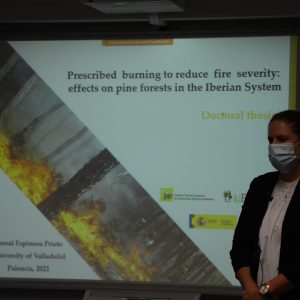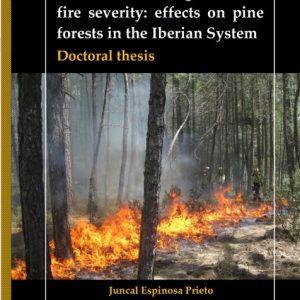Prescribed burning to reduce fire severity: effects on pine forests in the Iberian System
| PhD in Conservation and Sustainable Use of Forest System |
| Doctor: Juncal Espinosa Prieto |
| Date of reading: 4/06/2021 |
| Directors: Dra. Carmen Hernando Lara, Dr. Javier Madrigal Olmo. |
| Court: Leonor Calvo Galán (president), Pablo Martín Pinto (secretary), Daniel José Vega Nieva (vocal) |
Introduction

Wildfires are a global phenomenon, occurring on most continents and affecting a wide range of ecosystems. To the extent that predictive climate models indicate a more frequent occurrence of extreme meteorological episodes, more intense and severe fires are expected. Overall, these high-intensity wildfires are characterized by negative ecological and socio-economic effects, involving the loss of different ecosystem services, goods and even human lives, and also contributing substantially to carbon emissions. In addition, socioeconomic changes that occurred during the 20th century (e.g. rural land abandonment and the extension of wildland-urban interface areas) have exacerbated the problem. There is therefore a need to develop effective forest management systems to address these new scenarios. In this context, prescribed burning under canopy vegetation strata, usually carried out with low to moderate intensity, may increase wildfire protection, reducing the horizontal and vertical fuel continuity and promoting landscape heterogeneity. Despite its benefits, use of this fuel management tool in Spain remains limited and is often only carried out in strategic areas at a very local scale. However, efforts are being made to include prescribed burning in forest management plans, and the total area treated has increased in recent years.
Planning under-canopy prescribed burning involves preparing burn prescriptions in relation to meteorological variables, season and ignition patterns, as these factors determine fire behaviour. Interactions between the aforementioned factors and some species traits might accentuate or decrease the stress on ecosystems, although in many cases, the way in which species respond to the perturbation is uncertain. Although, prescribed burning seems to be a potentially valuable management tool in some forest ecosystems, increasing stand resilience with apparently minimal effects, some data gaps have been identified regarding application of the treatments.
Development
In this context, the goal of this doctoral thesis was to examine the integrated effect of two seasons of low-intensity prescribed burning in the medium-term at both tree and stand level. For this purpose, a pure stand of Pinus nigra and a mixed stand of Pinus nigra and Pinus pinaster in the Cuenca Mountains (Iberian System) were chosen. In the study area, these species generate an ecotone of stable stands, which should be taken into account in prescribed burning treatment programmes. Three treatments were carried out in both types of stand: prescribed burning in autumn, prescribed burning in late spring and no burning. Investigation of the effects of the joint disturbance on crown, via the amount and patterns of litterfall, damage in cambium area and tree growth enabled us to understand, for the first time, the responses of this kind of stands to perturbation. Research on the response of trees to prescribed burning in Europe is disperse, and the data obtained in this doctoral research may provide new information, or expand on existing knowledge, enabling the design, implementation and testing of more effective prescriptions.
Conclusions
This doctoral thesis includes five scientific articles, published in international, peer-reviewed, scientific journals and which analyze different aspects related to the main objective. The articles are presented in their original form and are organized in three chapters.
The doctoral thesis was awarded with a Cum Laude distinction by unanimity, as well as with the International Mention after a three-month internship at the University of Trás-os-Montes e Alto Douro in Vila Real (Portugal).
